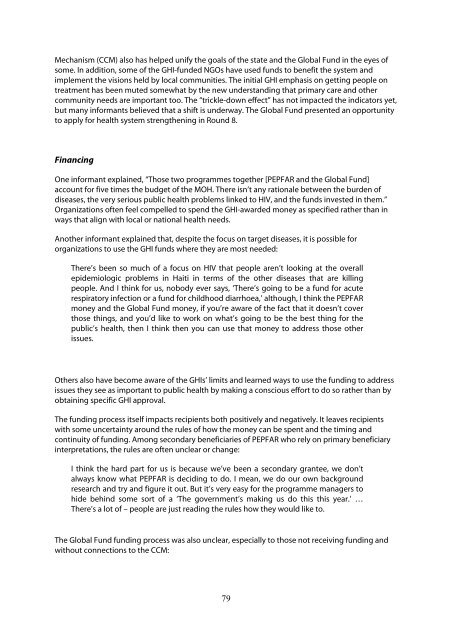MAXIMIZING POSITIVE SYNERGIES - World Health Organization
MAXIMIZING POSITIVE SYNERGIES - World Health Organization
MAXIMIZING POSITIVE SYNERGIES - World Health Organization
You also want an ePaper? Increase the reach of your titles
YUMPU automatically turns print PDFs into web optimized ePapers that Google loves.
Mechanism (CCM) also has helped unify the goals of the state and the Global Fund in the eyes of<br />
some. In addition, some of the GHI-funded NGOs have used funds to benefit the system and<br />
implement the visions held by local communities. The initial GHI emphasis on getting people on<br />
treatment has been muted somewhat by the new understanding that primary care and other<br />
community needs are important too. The “trickle-down effect” has not impacted the indicators yet,<br />
but many informants believed that a shift is underway. The Global Fund presented an opportunity<br />
to apply for health system strengthening in Round 8.<br />
Financing<br />
One informant explained, “Those two programmes together [PEPFAR and the Global Fund]<br />
account for five times the budget of the MOH. There isn’t any rationale between the burden of<br />
diseases, the very serious public health problems linked to HIV, and the funds invested in them.”<br />
<strong>Organization</strong>s often feel compelled to spend the GHI-awarded money as specified rather than in<br />
ways that align with local or national health needs.<br />
Another informant explained that, despite the focus on target diseases, it is possible for<br />
organizations to use the GHI funds where they are most needed:<br />
There’s been so much of a focus on HIV that people aren’t looking at the overall<br />
epidemiologic problems in Haiti in terms of the other diseases that are killing<br />
people. And I think for us, nobody ever says, ‘There’s going to be a fund for acute<br />
respiratory infection or a fund for childhood diarrhoea,’ although, I think the PEPFAR<br />
money and the Global Fund money, if you’re aware of the fact that it doesn’t cover<br />
those things, and you’d like to work on what’s going to be the best thing for the<br />
public’s health, then I think then you can use that money to address those other<br />
issues.<br />
Others also have become aware of the GHIs’ limits and learned ways to use the funding to address<br />
issues they see as important to public health by making a conscious effort to do so rather than by<br />
obtaining specific GHI approval.<br />
The funding process itself impacts recipients both positively and negatively. It leaves recipients<br />
with some uncertainty around the rules of how the money can be spent and the timing and<br />
continuity of funding. Among secondary beneficiaries of PEPFAR who rely on primary beneficiary<br />
interpretations, the rules are often unclear or change:<br />
I think the hard part for us is because we’ve been a secondary grantee, we don’t<br />
always know what PEPFAR is deciding to do. I mean, we do our own background<br />
research and try and figure it out. But it’s very easy for the programme managers to<br />
hide behind some sort of a ‘The government’s making us do this this year.’ …<br />
There’s a lot of – people are just reading the rules how they would like to.<br />
The Global Fund funding process was also unclear, especially to those not receiving funding and<br />
without connections to the CCM:<br />
79

















